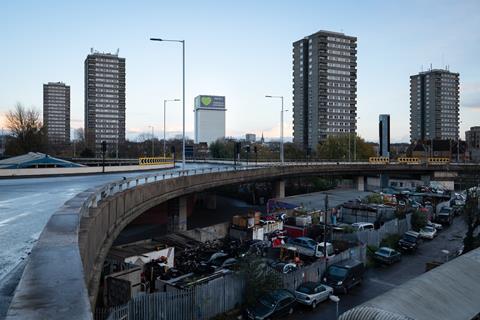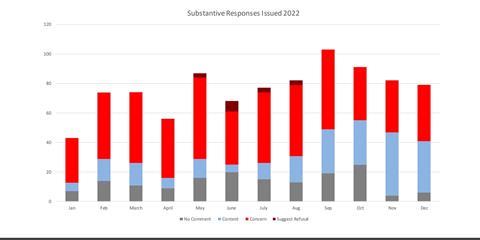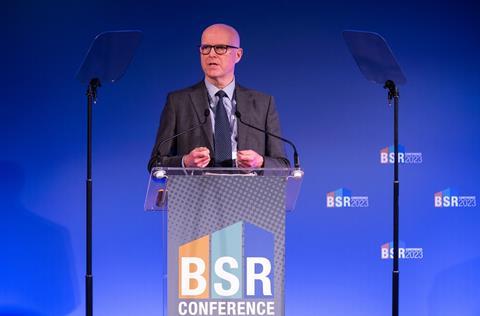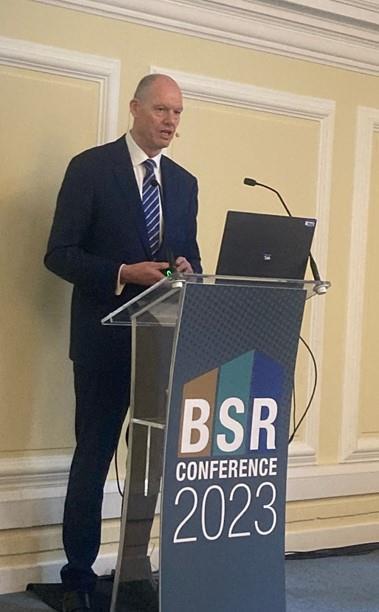The ║├╔½¤╚╔·TV Safety RegulatorÔÇÖs registration process for high-rise buildings starts in a few daysÔÇÖ time. Carl Brown assesses how prepared the new regulator and the industry are for the start of a fresh regime

Travel back just 10 years into the past and an event for construction professionals on building safety regulations would have drawn a well-intentioned but small audience, most likely safety experts keen to talk to like-minded people in their field. Cut to last week and the ║├╔½¤╚╔·TV Safety RegulatorÔÇÖs first conference saw hundreds of professionals from across the construction industry pack into the 2,300-capacity Westminster Central Hall. It felt more like a rock concert or a West End show than an industry event.
The reason? This was the first chance for many to hear first-hand from the new regulator, which sits within the Health and Safety Executive (HSE) and is expected to play a huge role in winning back trust to the industry post-Grenfell Tower tragedy.

The concept of a regulator is certainly starting to feel more real now. The role has its own logo and branding and, from early next month [6 April], will open its process for building owners to register around 12,500 high-rise buildings.
This is seen by many as the ÔÇ£launchÔÇØ of the new regime, as it is the first time the BSR will place requirements on firms using its powers under the ║├╔½¤╚╔·TV Safety Act.
Peter Baker, the chief inspector of buildings at the HSE and head of the BSR, certainly emphasised the significance of the occasion on the great hall stage last week. The registration milestone will, he said, ÔÇ£usher in a new era for building safety regulationÔÇØ. He added that he was aiming for a ÔÇ£world-leadingÔÇØ regime.
But how ready is the new regulator for the gargantuan task at hand? And is the industry prepared for the new era?
The regulator and its origins
Before we delve into where we are currently, it is worth a brief reminder of how we got here. The terrible events at Grenfell Tower in June 2017, which caused the deaths of 72 people, led the government to commission a review of building regulations and fire safety.
The eventual report, by Dame Judith Hackitt, called not just for tweaks to the specification of cladding systems but for a ÔÇ£radical rethinkÔÇØ of regulation in an industry that, Hackitt said, ÔÇ£has not reflected and learnt for itselfÔÇØ. Hackitt took aim at the industryÔÇÖs ÔÇ£ignoranceÔÇØ of the rules, its ÔÇ£indifferenceÔÇØ, its inadequate regulatory oversight and a lack of clarity over regulatory roles and responsibilities.
At-a-glance: the ║├╔½¤╚╔·TV Safety RegulatorÔÇÖs role
- To oversee the safety and standards of all buildings.
- Regulate the building control profession, through new registration requirements, a competence framework, codes of conduct and performance standards, with a ÔÇ£level playing fieldÔÇØ between public and private control bodies.
- Owners of higher-risk residential buildings ÔÇô defined as over 18m in height ÔÇô will have six months from April to register their buildings with the BSR. They will have to perform a building safety risk assessment, introduce measures to manage risks and produce a safety case report for their building. From April 2024 the BSR will issue building assessment certificates.
- Introduce a ÔÇ£gatewayÔÇØ system, under which the BSR will assess whether risks and roles and responsibilities are understood at different stages of construction.
- At the planning stage, known as ÔÇ£gateway oneÔÇØ the BSR is a statutory consultee and can raise concerns about fire safety risks in plans for high-rise residential buildings. This is not part of the ║├╔½¤╚╔·TV Safety Act and came into effect in 2021.
- At the design stage, before work starts, clients must be able to demonstrate how proposals comply with requirements. This is expected to come in after October. The BSR will require information about how requirements governing the competence of dutyholders (including the clients, designers, principal designers, contractors and principal contractors), the ÔÇ£golden threadÔÇØ record of information about the building and reporting requirements will be met.
- Applicants will have to demonstrate that they have appropriate strategies to manage the construction phase to support building regulations compliance and reduce the possibility of building safety risks arising.
- During the construction phase, those involved in the design and construction process will be required to notify the BSR of major changes to the scheme and meet record-keeping requirements and maintain accurate information to hand to the building owner at planning gateway three.
- The HSE has already set up a residents panel, a requirement under the act.
Key dates
- 6 April - period for owners to register high-risk occupied buildings technically opens
- 12 April - digital portal for registrations expected to launch
- 1 October- period for high risk buildings registration ends
- October - regulations for gateways 2 and 3 expected to come into effect
- October - BSR to take over regulation of the building control profession
- April 2024- BSR to start issuing building assessment certificates
The reportÔÇÖs recommendations, including the formation of a new regulator, have largely been adopted by the government, with the bulk of the changes coming in this year.
These consist of regulation of building control, including registration and certification requirements, and a three-part ÔÇ£gatewayÔÇØ system under which the BSR has to be satisfied that requirements are met during the planning, design and build phases of a scheme (see box). Competency and information-sharing requirements among defined ÔÇ£dutyholdersÔÇØ will also need to be met.
The reforms are wide-ranging and complex and this is presumably the reason why a huge, information-hungry crowd of nearly 1,000 people packed into the Westminster event last week.
Gateway one
It is worth saying that the HSE in its regulator role has already been involved in ÔÇ£planning gateway oneÔÇØ under separate regulations not in the ║├╔½¤╚╔·TV Safety Act.
Since August 2021 the HSE has been a statutory consultee for planning applications involving high-risk buildings. This means local planning authorities have had to consult the regulator before granting planning permission.
The HSE set up a small team of 12 people, including six fire safety assessors, to check planning applications against standards and guidance. Last summer the HSE was raising concerns about well over half of the applications it was checking (see graph).
Although that statistic has since improved, Baker said the number of instances of concem shows the message that fire safety needs to be considered in the earliest stages of the life of a high-rise building ÔÇ£has not yet fully landedÔÇØ. And this needs to change, he said.

In each month from May to August last year the HSE recommended the refusal of schemes in a handful of instances. Mark Wilson, planning gateway one service lead at the HSE, admitted to the conference that last summer had been a ÔÇ£torrid timeÔÇØ, although things have improved in recent months.
Interestingly Wilson said there were cases where it recommended refusal due to the local authority not making progress with a developer, whereas actually the developer was simply confused.
ÔÇ£We werenÔÇÖt speaking enough to developers who are struggling with the new regime and so now, before we get to the point of suggesting refusal, we will always try and meet with the developer to try and resolve the issues or explain our perspective, he said.ÔÇØ
Wilson said 60 or 70% of concerns raised by the HSE were connected to single staircases, including concerns around firefighter access and travel distances and how the single staircase connects with other areas of the building. Wilson points out that single stairs are allowed for the time being, while the government consults on a potential ban, but cautioned: ÔÇ£We will be looking to make sure that the single stair is protected to the highest level possible through built-in inherent design features.ÔÇØ
WhatÔÇÖs in store from April
The planning gateway one activity however is small fry compared with the workload the fledgling BSR will be taking on in the coming weeks and months.
From 6 April the new rules requiring building owners to register their high-risk residential buildings with the BSR will technically come into effect, although the BSRÔÇÖs new digital portal for logging registrations will not be live until around 12 April. ║├╔½¤╚╔·TV owners will then have less than six months to register, with failure to do so within the timescale regarded as a criminal offence.
Given the sheer number of buildings to be registered ÔÇô and then all the gateway two and building control requirements later in the year ÔÇô all eyes will be on whether the BSR has the resources to cope.

ÔÇ£My perception from my reading and those I have spoken to in the industry is that the regulator will struggle to cope with the volume of applications and the number of queries which will come through, thus causing delays,ÔÇØ said Simon Tolson, senior partner at Fenwick Elliott and speaking to ║├╔½¤╚╔·TV in his capacity as a ║├╔½¤╚╔·TV the Future commissioner.
With 12,500 buildings requiring registration in just six months, Tolson said resources were likely to be a key factor. ÔÇ£ItÔÇÖs crucial the registration process is well resourced by the BSR/HSE, particularly given that the risk of criminal liability and even imprisonment is the stick,ÔÇØ he added.
In return he said the industry should ÔÇ£expect and deserve a match-fit regulatorÔÇØ.
Baker is certainly aiming high, promising the BSR conference that he wants to establish a ÔÇ£world-leadingÔÇØ regulatory regime.
An HSE spokesperson told ║├╔½¤╚╔·TV that it currently has 200 people employed in its BSR function and plans to recruit a further 462 in 2023-24. She added that it has ÔÇ£necessary resourcesÔÇØ in place for the registations.
It is not clear how many of these 662 will be recruited before October, when the regulator takes on more functions.
Andrew Mellor, partner at PRP and another ║├╔½¤╚╔·TV the Future commissioner, also wonders whether the BSR has enough people and stressed the importance of the BSR having a digital registration and application portal ÔÇ£that is user-friendly, robust and does not crashÔÇØ.
Rebecca Rees, partner at Trowers & Hamlin and a third commissioner, is concerned about the impact of delays should the BSR not sign off building completion certificates within the promised 12-week timescale at gateway three. ÔÇ£It does not seem that there will be any sanctions for the BSR in the event that it does not stick to its timescales,ÔÇØ she said.
In response, the HSE spokesperson countered: ÔÇ£The key to avoiding delays will be to ensure all the necessary information is available to evaluate within each application.ÔÇØ
Changes for building control officers
Another area where resourcing may prove tricky is within local authority building control. Under the act, regulation and registration requirements will apply to all building control surveyors for the first time.
ÔÇ£ItÔÇÖs crucial the registration process is well resourced by the BSR/HSEÔÇô particularly given the risk of criminal liability and even imprisonment is the stick.ÔÇØ
Simon Tolson, senior partner, Fenwick Elliott
Lorna Stimpson, chief executive of Local Authority ║├╔½¤╚╔·TV Control (LABC), told ║├╔½¤╚╔·TVÔÇÖs earlier this month that she was concerned about an exodus of highly-skilled people from the industry who were considering retiring or changing career rather than grappling with the new requirements.
It was perhaps telling that the Department for Levelling Up, Housing and Communities (DLUHC) recently felt the need to announce a £16.5m fund for the LABC to hire 110 building inspectors, along with £26m for fire services to hire 111 new fire protection officers.
Despite welcoming the extra funding, Stimpson pointed out that there is little point in bringing in new people unless there are more experienced surveyors to train them. ÔÇ£You learn building control from those senior people who you work with,ÔÇØ she said, ÔÇ£so without them, our profession is in demise.ÔÇØ
The LABC, the BSR and ministers will all be hoping that the building control function is not too decimated by October, when the new requirements come into effect.
Secondary legislation
While building control professionals may be scratching their heads at the huge regulatory change, the rest of the industry has also got a great deal to get its collective head around, not least meeting all the gateway two requirements, the regulations for which have yet to be finalised.
Mark Reynolds, co-chair of the Construction Leadership Council, pointed out to the BSR conference that ÔÇ£there are 32 different pieces of secondary legislation, that have either gone through a consultation process or are going through the consultation processÔÇØ.
In response the CLC has set up a new workstream looking at regulatory clarity and providing feedback to the government. Reynolds added: ÔÇ£We need to keep close to what is happening over the next few months.ÔÇØ
He said there was a need to establish the standards and regulations, which is the governmentÔÇÖs responsibility. But it was the industryÔÇÖs job to ensure it has a ÔÇ£skilled and competent workforce and [that] we have got capability and capacityÔÇØ.
When it comes to competence, the act relies to an extent on the industry itself to develop its own ways of measuring and certifying that people are competent to do the work they need to do, although the BSR will set up an Industry competence committee to help monitor progress.
Questions around competence
The most active work by the industry in this area has been done by the competence steering group (CSG), made up of 150 organisations in the built environment.

The CSG has set up 12 working groups to draw up competence frameworks. The groupÔÇÖs co-chair, and CIC chief executive, Graham Watts said literally ÔÇ£hundreds if not thousandsÔÇØ of people have been involved.
Watts added: ÔÇ£We now have a platform, we have the standards in place pretty much across the board.
ÔÇ£But what we need to do now is translate those standards into actual qualifications, continuing professional development and training. That is the most important and vital next step that we need to be getting on with over the next year.ÔÇØ
Passive Fire Knowledge Group
An example of sections of the industry working together to improve safety is the Passive Fire Knowledge Group (PFKG). Under gateway two, principle contractors must be able to provide technical assurance that the designs are correct and meet regulations before work can begin on the project.
But among some of the largest contractors in the industry there is concern that providing this assurance could prove tricky because of issues inherited from the design stage, where different components may not be compatible with each other.
The PFKG, made up of ten tier one contractors and trade bodies the Association for Specialist Fire Protection (ASFP), ║├╔½¤╚╔·TV & Engineering Services Association, Finishes and Interiors Sector and consultancy ADDC, is looking at ways to improve this situation.
Other regulators
Another area of uncertainty in the industry is the relationship between the BSR and numerous other regulators in the building safety space, and what happens when there is confusion over regulatory overlap.
For instance, the fire and rescue services regulate on fire safety orders, the beefed-up Regulator of Social Housing will have powers over the maintenance of many residential blocks, a new National Regulator for Construction Products is being created, and there are the aforementioned building control teams in local authorities in addition to environmental health departments. What happens if messaging or guidance from different regulators conflicts?

Rees and Mellor suggested to ║├╔½¤╚╔·TV that there should be one central body or advice line to prevent confusion. After all, Hackitt recommended the establishment of a Joint Competent Authority, involving the LABC, fire authorities and the HSE to oversee safety cases.
Baker seems well aware of this. He told the conference the BSR was working through these issues with other regulators and looking at developing a memorandum of understanding (MOU) to ensure clarity over who is responsible for what, with the BSR not necessarily always the prime regulator in every area.
ÔÇ£The last thing anybody wants is the BSR engaging with you on a Monday, the fire service on a Tuesday and then the Regulator of Social Housing,ÔÇØ he said.
Rees said the success of the BSRÔÇÖs plan to mitigate this would ÔÇ£all depend on how detailed the MOU will be, and whether it will allow landlords sight or upfront detail as to who will be turning up and when on their doorstepÔÇØ.
More regulations on the horizon
In just a few daysÔÇÖ time, the great increase of regulatory activity begins, with registration of occupied buildings, followed by the flood of further regulation and reporting requirements, competency rules, golden thread requirements, requirements to build safety cases and more from October onwards.
It is clear that the fledgling BSR has a huge job to do, with question marks about its capability and resources among what Baker describes as a ÔÇ£complex patchworkÔÇØ of regulation.
This is the last chance saloon for the construction industry
Peter Caplehorn, chief executive, Construction Products Association
But, in many ways, the biggest job is being done by the industry itself. And some are concerned that this might be the final opportunity it gets to sort its house out on the issue of building safety.
Peter Caplehorn, chief executive of the Construction Products Association, told the conference: ÔÇ£This is the last chance saloon for the construction industry, we have got to take advantage of this situation and use it to the fullest.ÔÇØ
His words echoed BakerÔÇÖs rallying call to conference delegates, imploring the industry to ÔÇ£take ownership of the risksÔÇØ in its buildings.
Watts said: ÔÇ£I have been working in the industry for 44 years and for the first 38 of those years I can never remember sitting in a room talking about the safety of residents and occupants of the buildings we were producing. It was just taken for granted. But now I donÔÇÖt spend a single day without talking about it.ÔÇØ
Watts however said his main concern is that he is still meeting people in the industry ÔÇ£who donÔÇÖt think the new regime, the new culture applies to themÔÇØ.
ÔÇ£ItÔÇÖs important we get the message across that these changes are for everyone,ÔÇØ he added.
The regulatory changes coming down the road are enormous. The construction industry can only hope that the BSR will have the resources, IT support and necessary nous to ensure the new era gets off to a great start.
But all eyes are also on the industry. For many, its reputation is once again on the line.
The ║├╔½¤╚╔·TV the Future Commission

The ║├╔½¤╚╔·TV the Future Commission is a year-long project, launched to mark ║├╔½¤╚╔·TVÔÇÖs 180th anniversary, to assess potential solutions and radical new ways of thinking to improve the built environment.
The major projectÔÇÖs work will be guided by a panel of 19 major figures who have signed up to help guide the commissionÔÇÖs work culminatuing culminate in a report published at the end of the year.
The commissioner include figures from the world of contracting, housing development, architecture, policy-making, skills, design, place-making, infrastructure, consultancy and legal.
The building safety stream of the ║├╔½¤╚╔·TV Future Commission will look at unique approaches to the ║├╔½¤╚╔·TV Safety Act as well as longer-term solutions across a wide range of issues all intended to improve safety considerations in the way developments are designed and built.


























No comments yet